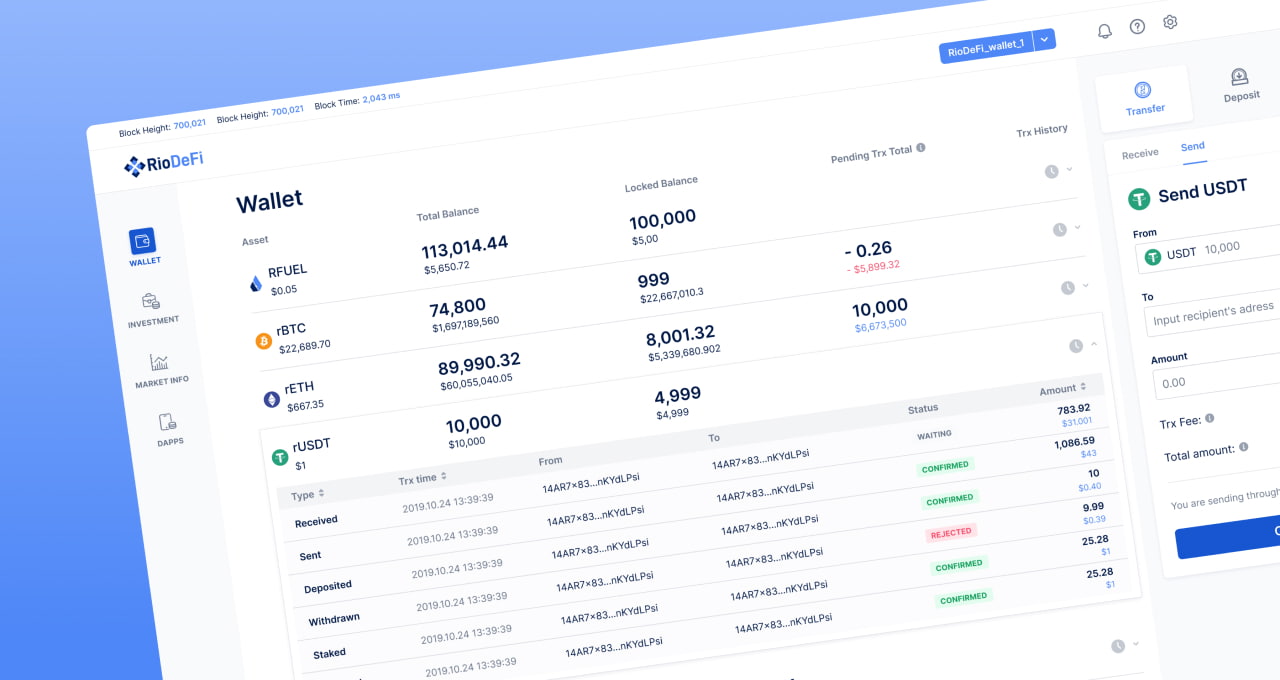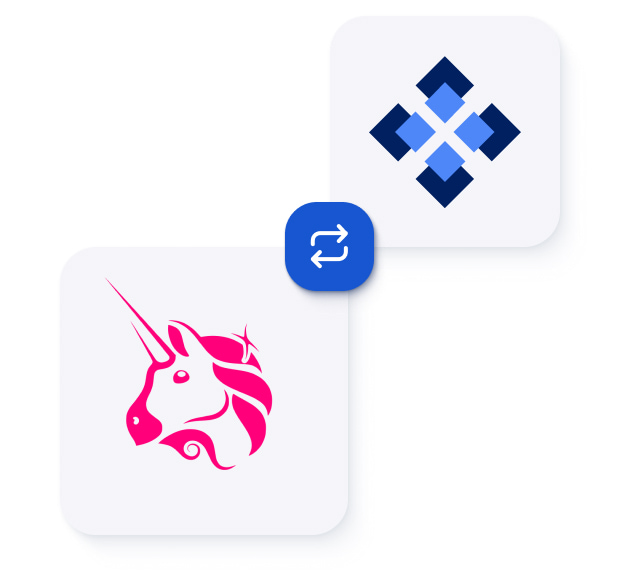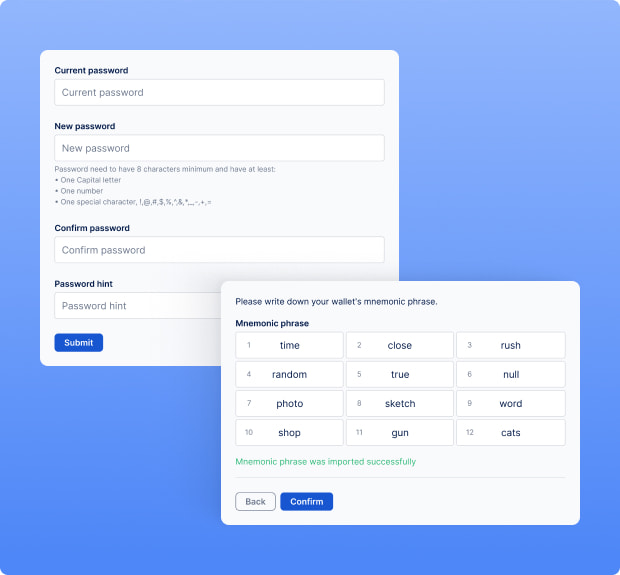
- Home
- Success stories
- Rio DeFi
About the client
Rio DeFi is a blockchain development company whose mission is to bridge the gap between conventional and decentralized finance and enable digital assets to go mainstream. The company works on various DeFi, NFT, and GameFi applications created on top of their own blockchain protocol.Details
- Location:Hong Kong
- Date:2020-2021
Rio DeFi’s global goals
Our client shared the main goals of their project and we identified four directions to our work accordingly:
- 1
DeFi
Empower financial institutions to leverage digital assets and alternative currencies and help their clients manage their funds effectively through easy-to-use solutions.
- 2
Web3
Provide businesses with the tools to successfully transition into a new technological era where decentralization, blockchain, and tokens will be the new normal.
- 3
Globalization
Simplify the use of financial services through apps that will reduce the number of intermediaries and make payments much faster and more conveniently.
- 4
Scalability
Ensure that the developed DeFi solutions are scalable and suitable for mass adoption.
Work done
Substrate-based fork for Rio Chain
EVM improvement, adaptation, and integration
Uniswap-like DEX
Blockchain explorer
Web3 browser extension
Cross-chain token bridge
OAuth keyless system
RNG system
Audit trail system
Web and mobile crypto wallet

Solution
PixelPlex helped Rio DeFi create and modify the ecosystem infrastructure using the Substrate framework as well as develop new components such as a blockchain explorer, audit trail and RNG systems, a web and mobile wallet, and a Web3 browser extension. Overall, our team deployed 13 smart contracts. These improvements have made the system much more flexible and scalable.
Rio DeFi ecosystem in focus
Rio Chain infrastructure
Rio DeFi’s core technology is Rio Chain — a blockchain protocol initially created by the company. The Polkadot development team modified the protocol by developing a separate fork based on the Substrate technology that Polkadot is powered by, and customized the solution according to our client’s requirements.
Why Polkadot?
Allows for cross-chain compatibility
Shows great network scalability thanks to its parachain technology
Provides a high transaction speed, up to 3,000 tps

EVM customization and integration
Right after the creation of the Substrate fork, we started adapting the Ethereum Virtual Machine (EVM) to integrate it with Rio DeFi.
When we were working on the project, there was no plugin that would easily integrate with our type of protocol, so we made an effort to ensure that the EVM was configured and built in properly.
We did the following:
Took the EVM pallet as a basis, created a fork, changed its logic, and reconfigured it to be suitable for the Rio Chain protocol.
Integrated the EVM with our blockchain and thus made it possible to execute smart contracts on the Polkadot side.
Created a Web3 browser extension to provide an experience similar to Ethereum by signing transactions through a Metamask-like plugin.

Web wallet with staking support
The creation of Rio Wallet was one of the biggest and most important parts of our work, as it is the primary way users interact with the ecosystem and its applications.
The existing wallet from the client had only the basic functionality of an ecosystem wallet and experienced several major issues:
It did not meet business requirements and had poor UX/UI design
It wasn’t secure enough
Most of its features didn’t function properly

Consequently, our team needed to redesign the wallet. We changed its logic, created a design from the ground up, added brand new features, and expanded the wallet’s functionality:
Enabled funds transfer, receipt, and withdrawal
We placed the transaction information and the window for transferring and withdrawing funds on the same screen so that the user could track data and use the transfer/receive functions with just a few clicks.
Introduced the staking functionality
We wrote smart contracts and created a staking pool in the wallet. Users can lock their tokens for a preferred amount of time and earn daily rewards.
Implemented multi-chain support
Our developers provided support for three chains: Rio Chain, OKEX Chain, and BSC Chain. Users can choose which wallet and chain they want to use when entering the Rio DeFi ecosystem and accessing its applications.
Integrated HexTrust
Our team introduced this digital asset custodian to provide secure distributed storage of private keys.
Added market data
We integrated the wallet with CoinGecko so that users could conveniently view and track market information such as exchange rates, and as a result make more informed investment decisions.
Enabled dApps support
We added a blockchain-section for dApps where users can check applications based on Rio Chain, OKEX Chain, and BSC Chain and connect to them through the Rio wallet.
Added transaction history
We configured the design so that users could simultaneously view their total balance, locked balance and transaction history. All the necessary information is always at hand.
Made it possible to check balance and currency rates in fiat
Our team added support for three fiat currencies: USD, EUR, and CNY. Users can choose in which currency they want to see the equivalent of their balance and currency exchange rates.
Made the onboarding process easier
We implemented a blockchain-section with explanatory videos and onboarding screens to make it easier and faster for users to learn the platform and start using it.
Blockchain explorer
We forked the existing Substrate Explorer, customized it and added support for an audit trail, a Hybrid Database system, and multi-chains. Now, users can conveniently monitor the Rio network and view important transaction details such as:
Latest blocks
Latest transactions
Status of the transactions
Fees paid per transaction
Smart-contract code execution results
Staking details
Audit trail statistics
On-chain statistics
OAuth keyless system
To simplify the sign-in process, we implemented an OAuth keyless system. This allows platform users to create an account and access assets only using their email or social media instead of having to make up and remember passwords.


Uniswap fork for crypto exchange
Our team did research and development for a working prototype of the Uniswap-based cryptocurrency exchange that allows for decentralized token swaps.
Thanks to our successful EVM integration and the addition of Web3 support via the browser extension, Uniswap forking did not take much time or require serious code changes. Developers can now seamlessly migrate their dApps to Rio DeFi, while benefiting from a significantly faster protocol.
During this cryptocurrency exchange development process, we implemented the following functions and features:
Liquidity pool
Polkadot support
Web3 support
The ability to connect to a wallet before swapping currencies
Support for working with assets through precompiles
Implementation of wrapper contracts for external tokens
The ability to set transaction deadline to avoid long waiting times
Audit trail system
Since the Rio DeFi ecosystem includes many projects and applications that aim to be fair and transparent, it needed its own audit trail system. To make this possible, we developed an audit trail system from scratch.
The system allows any user to check the sequence of transactions and send a request and verify that the Rio DeFi-based gaming app generates a truly random number.

RNG system
Since the Rio DeFi ecosystem includes many projects and applications that aim to be fair and transparent, it needed its own audit trail system. To make this possible, we developed an audit trail system from scratch.
The system allows any user to check the sequence of transactions and send a request and verify that the Rio DeFi-based gaming app generates a truly random number.
Fair
Verifiable using cryptographic proofs
100% random based on unique entropy
The components developed by our team for the Rio DeFi ecosystem are vital for both users and dApp developers. Now users can enjoy reliable and fast transactions and are able to check how fair an operation was. Meanwhile, developers can create their own dApps without having to completely rewrite the code or build solutions from scratch.
Tech stack
Project features
- High scalability achieved through Polkadot’s parachains
- High transaction speed
- EVM compatibility
- Web3 support
- Fair, transparent, and verifiable transactions
- Enhanced blockchain platform statistics
- Easy wallet authentication
Services
We offer a comprehensive range of services, including IT consulting, custom software development, and specialized expertise in blockchain, machine learning, and data science.
Blockchain Development
Blockchain Development
Smart Contract Development
Web3 Development
Crypto Payment Solutions
Tokenization Services
Protocols
Protocols
Cryptocurrency Exchange Development
Cryptocurrency Development
Top Development Company
Blockchain Consulting
Top Blockchain Consulting Company
Custom Software Development
Mobile App Development
Web Development
Top IT Services Company
IT Consulting
Top Consulting Company
ML Development
Artificial Intelligence Development
Machine Learning Development
Data Science Development
Top BI & Big Data Company
AR & VR Development
AR & VR Development
QA & Software TestingQA & Software Testing Services
UI/UX DesignGive us the pleasure of adding our secret sauce to your app.
We’ll create beautiful screens at the front while breaking the limits of what’s behind them to help your app get to beyond-plausible business achievements.
UI/UX Design Services
MVP DevelopmentValidate your product idea quickly with an MVP—launch faster, test smarter, and refine based on real user feedback.
Leverage our expertise in MVP development to build a scalable, market-ready product with minimal risk and maximum efficiency.
MVP Development Services
Metaverse Consulting & DevelopmentValidate your immersive concept quickly with metaverse development — launch your virtual experience, gather actionable user insights on core features like avatars and social interaction, and iterate based on real-world engagement.
Top Development Company
Solutions
RWA PlatformTokenization makes it easier to trade assets and opens up new investment opportunities and diversifies portfolio.
RWA Platform
Asset tokenization platform development
Arbitrage BotProfit from market inefficiencies with automated, customized trading strategies that boost returns and minimize risk.
Arbitrage Bot
Be a transaction ahead. Catch profit at short notice
CryptoAPIGain an unfair data edge for your dApps. Tap into high-quality blockchain insights to outsmart competitors and fuel smarter decisions.
CryptoAPI
Connect your dApps to blockchain networks in a flash
OTC HawkOffer high-net-worth clients a secure, enterprise-grade trading terminal. Streamline deals, enhance reliability, and optimize top-tier crypto assets.
OTC Hawk
Benefit from our portfolio and wealth management app
DocFlowManage sensitive documents on blockchain. Leverage optional zero-knowledge proofs for trust, privacy, and streamlined workflows.
DocFlow
Intuitive Blockchain-Powered Document Management System
Know-Your-TransactionEnsure every transaction is above board. Monitor digital asset flows for compliance and transparency, supporting both businesses and regulators.
KYT crypto platform
Our KYT platform fosters integrity of financial ecosystems
Industries
We work across a variety of industries, from FinTech to eCommerce, leveraging our accumulated knowledge and best practices to deliver solutions tailored to the unique needs of your business.
FinTech & BankingAs traditional finance goes digital, we are committed to building efficient ecosystems and better engagement.
Think of customized FinTech solutions with tamper-proof transactions and storage, progress transparency and automation — and we’ll make them see the light of day.
$25T
Global Financial Services
20%
Digital/Blockchain Growth
Solutions for FinTech & Banking
Retail & eCommerceWhether you market B2B or B2C, commerce tech trends are all about value-driven purposes, global sustainability, hybrid shopping journeys, and extra-resiliency.
Let your clients know that there’s more to your brand than meets the eye by creating unique customer experiences in all your stores.
$6.3T
Global eCommerce
10-15%
Tech Innovation Growth
Solutions for Retail & eCommerce
Supply Chain & LogisticsTo make things easier for all vendors, we deliver apps for route and cost optimization, vehicle operational support, and better dispatch time efficiency.
With focus is sustainability, resilience, transparency, and immutability, let’s get your transformation going.
$10T
Global Logistics
15-20%
Blockchain Adoption Growth
Solutions for Supply Chain & Logistics
HealthcareCustom healthcare software solutions are aimed at helping you ensure accurate diagnosis, better patient engagement, and positive healthcare outcomes.
Whether you require a patient management solution, practice management software, EMR/EHR system, or ML-enabled diagnostics – we’ve got you covered.
$10T
Global Healthcare
20%
Digital/Blockchain Growth
Solutions for Healthcare
Real EstateKeep up with digital innovation trends by accelerating enterprise transformation and scaling, leveraging data and orchestrating workflows.
Whether you manage and sell commercial facilities or invest third-party capital, our integrated solutions help you make the most of it.
$340T
Global Real Estate
15%
PropTech/Blockchain Growth
Solutions for Real Estate
Oil & GasWith mobility and digital technologies standing to change the game and define leadership, our mission is to get you digital-first.
Resolve operational and conceptual issues by introducing clear tech vision, feasible architectures, and flexible software to take business extension off limits.
$4T
Global Oil & Gas Industry
10-15%
Digital/Blockchain Growth
Solutions for Oil & Gas Industry
InsuranceImagine a world where quoting policies, processing claims, and managing mountains of paperwork are effortless. PixelPlex can help you achieve just that.
Break free from outdated systems and focus on what truly matters – delivering exceptional service to your policyholders and growing your insurance business.
$25T
Global financial services
20%
Digital/blockchain growth
Solutions for Insurance Industry
FitnessWe create custom fitness software solutions that support meaningful training and steady engagement from the first session.
If you’re building a digital product for active users and need a team with real project experience behind it, we’ll help you bring it to life with clarity and purpose.
$257B
Global Fitness Industry
24%
Digital Growth
Solutions for Fitness
Success stories
Domain
Industry
Protocols
Company
About us Team Careers Social Responsibility ContactsBlog
Blockchain Big Data Artificial Intelligence AR/VR Mobile News View Blog